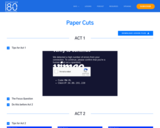
Use this three act task to have students make predictions and determine which area is the greatest.
- Subject:
- Mathematics
- Material Type:
- Activity/Lab
- Provider:
- Estimation 180
- Author:
- Andrew Stadel
- Estimation 180
- Date Added:
- 10/24/2022

Use this three act task to have students make predictions and determine which area is the greatest.
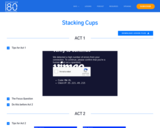
Use this three act task to have students create different representations to determine how many cups will have the stacks be the same height. Use to come up with a plan to solve systems of equations.
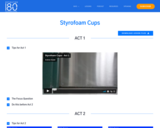
Use this three act task as students are learning about constant rate of change, slope and linear functions.

This task has students determine how much some yogurt costs. There are multiple ways to approach this problem including unit rates, proportions and scale factors. Allow your students to think creatively and critically as they work through this task.
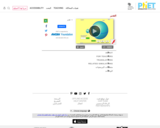
Explore size estimation in one, two and three dimensions! Multiple levels of difficulty allow for progressive skill improvement.

Familias y cuidadores: ustedes tienen un papel importante en el aprendizaje del lenguaje de sus hijos. Los niños pueden aprender palabras nuevas todos los días escuchando, hablando, escribiendo y dibujando. El propósito de esta actividad es ayudar a los niños a aprender y practicar un conjunto pequeño de palabras nuevas durante un tiempo, adaptándolas a su vocabulario.

Familias y cuidadores: ustedes tienen un papel importante en el aprendizaje del lenguaje de sus niños. Los niños pueden aprender palabras nuevas todos los días y desarrollar su vocabulario utilizando lenguaje descriptivo. Al jugar este juego, usted y su niño o niña utilizarán el lenguaje para describir y adivinar objetos del hogar escondidos.

Familias y cuidadores: ustedes tienen un papel importante en el aprendizaje del lenguaje de sus niños. Los niños pueden fortalecer su lenguaje todos los días, haciendo y respondiendo preguntas sobre una experiencia. En esta actividad, usted le pedirá a su niño o niña que hable sobre una experiencia que haya tenido.

Familias y cuidadores: ustedes tienen un papel importante en el aprendizaje del lenguaje de sus niños. Los niños pueden fortalecer su lenguaje todos los días, haciendo y respondiendo preguntas sobre una historia. En esta actividad, usted le pedirá a su niño o niña que hable sobre lo que lee, escucha o sabe sobre una historia.

Familias y cuidadores: ustedes tienen un papel importante en el aprendizaje del lenguaje de sus niños. Los niños pueden fortalecer su lenguaje todos los días, haciendo y respondiendo preguntas sobre un tema o un texto informativo. En esta actividad, usted le pedirá a su niño o niña que hable sobre lo que lee, escucha o sabe sobre un tema o un texto informativo.

Familias y cuidadores: ustedes tienen un papel importante en el aprendizaje del lenguaje de sus niños. Los niños pueden aprender palabras nuevas todos los días escuchando, hablando, escribiendo y dibujando. El propósito de esta actividad es ayudar a los niños a utilizar textos informativos, haciendo que aprendan y practiquen usando un pequeño conjunto de palabras nuevas del texto. Usted apoyará a su niño o niña mientras lee, habla, dibuja, juega o escribe las nuevas palabras.

Familias y cuidadores: ustedes tienen un papel importante en el aprendizaje del lenguaje de sus niños. Los niños pueden desarrollar su vocabulario aprendiendo y practicando nuevas palabras durante las tareas cotidianas, por ejemplo, al preparar una comida. En esta actividad, usted preparará una comida con su niño o niña, enfocándose en el proceso y las palabras nuevas y ayudándolos a escribir la receta.

Build a working Etch-A-Sketch using Google Sheets.

Download this librarian’s guide to see how to implement E-Textiles activities in your library. This guide includes a list of what you’ll need, tips for choosing a theme, ideas to run a library activity, a DIY (“How To”) guide for the youth, and E-Textiles stands for electronic textiles. You can create your own light-up clothes and teach youth circuitry and electronics at the same time.

As doctors and researchers continue to learn more about the relationships among genes, the environment, and diseases, they are making advances in predicting the likelihood of a person developing certain diseases as well as discovering innovations in the prevention and treatment of diseases. These are enhancing the notion of personalized medicine, which aims to customize an individual's health care by tailoring decisions and treatments based on his or her genetic information. The sequencing of the human genome was the first step in what many hope will be a new era in medicine. As in many medical advances, there are a number of ethical, legal, and social issues involved in personal genomics.

In this media-rich lesson, students explore some of the ethical, legal, and social issues related to personal genetic testing and genome sequencing.
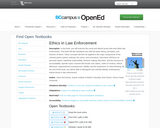
In this book, you will examine the moral and ethical issues that exist within law enforcement. This book will also familiarize you with the basic history, principles, and theories of ethics. These concepts will then be applied to the major components of the criminal justice system: policing, the courts, and corrections. Discussion will focus on personal values, individual responsibility, decision making, discretion, and the structure of accountability. Specific topics covered will include core values, codes of conduct, ethical dilemmas, organizational consequences, liability, and the importance of critical thinking. By the end of this book, you will be able to distinguish and critically debate contemporary ethical issues in law enforcement.

This video aims to delve into the human problems brought out by issues in artificial intelligence, specifically with respect to bias. It is suitable for classroom use or as a standalone video for those who wish to understand the issue more deeply than is conventionally covered. For classroom use, we recommend watching the chapterized version of the video and working through the teaching materials provided for each chapter.

In this video excerpt from NOVA, learn about the advantages, disadvantages, and ethical implications of preimplantation genetic diagnosis, or PGD, a technique used to screen embryos created through in vitro fertilization for diseases.

Linda Black Elk is passionate about plants. Linda Black Elk is an ethnobotanist and professor of ethnobotany and science education at Sitting Bull College in Fort Yates, North Dakota and recently she traveled to the Cansayapi Oyate (the Lower Sioux Indian Community) to share her knowledge of medicinal plants with students there.
Two lesson plans for grades 9-12 are included as gallery assets and in the Support Materials.